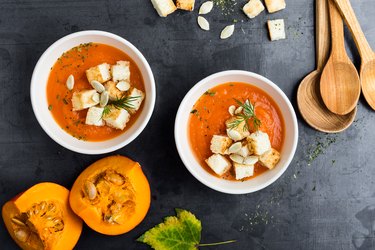
The jack-o-lantern and pumpkin pie may be the first things that come to mind when you think of pumpkin as food. But the pumpkin benefits go beyond decoration and treats. The bright orange gourd is packed with nutrients that promote health, including fiber.
Tip
Canned pumpkin has 7 grams of fiber per cup and is a high-fiber food.
Video of the Day
Pumpkin Nutrition Basics
It may be hard to believe that the star ingredient in your favorite holiday dessert is considered a vegetable based on its nutrition profile, but it's true. Like other vegetables, pumpkin is a nutritional powerhouse and filled with many nutrients that benefit your health.
Video of the Day
According to nutrition information from the USDA, one cup of boiled, mashed pumpkin has:
- 50 calories
- 2 grams of protein
- 12 grams of carbohydrates
- 2.7 grams of fiber
- 12 percent of the daily value (DV) for potassium
- 8 percent of the DV for iron
- 78 percent of the DV for vitamin A
- 13 percent of the DV for vitamin C
Canned pumpkin without salt is also packed with nutrition and is a better source of many essential nutrients when compared to fresh, cooked pumpkin. Pumpkin nutrition in one cup of the canned version provides:
- 83 calories
- 3 grams of protein
- 20 grams of carbohydrates
- 7 grams of fiber
- 11 percent of the DV for potassium
- 19 percent of the DV for iron
- 212 percent of the DV for vitamin A
- 11 percent of the DV for vitamin C
Read more: Does Pumpkin Help in Losing Weight?
Benefits of Pumpkin Fiber
Pumpkin can help you meet your daily fiber needs, whether you're eating fresh or canned varieties. According to the FDA, foods that contain 20 percent or more of the DV for fiber are high-fiber foods.
The daily value for fiber is 28 grams, which means a cup of canned pumpkin is a high-fiber food because it provides 25 percent of the DV. By comparison, the fresh, cooked pumpkin fiber content provides 10 percent of the DV.
For the record, the daily value (DV) is a reference number set by the FDA for the Nutrition Facts Label. Your daily fiber needs may depend on your sex and age. Women need 21 to 25 grams of fiber a day, and men need 30 to 38 grams.
Canned pumpkin may be a better source of fiber than fresh, but that doesn't mean you should exclude fresh pumpkin from your diet. Both sources of pumpkin fiber can help you reach your daily needs.
Getting an adequate amount of fiber in your diet from healthy sources like pumpkin helps keep you regular and protects you from many chronic illnesses, such as heart disease, diabetes and certain types of cancer. Fiber also keeps you feeling full longer and may support your weight-loss efforts.
Although most Americans know fiber is good for them, only 5 percent meet their daily fiber needs, according to a July 2017 article published in the American Journal of Lifestyle Medicine.
Read more: 7 Low-Sugar Pumpkin Dessert Recipes
Getting Those Pumpkin Benefits
Because it's low in calories and rich in essential nutrients that promote health, it's not too hard to see how adding pumpkin to your diet can maximize your nutrient intake. However, you may be at a loss about what you can do with pumpkin other than turning it into a sweet, delicious pie.
In addition to being high in fiber and convenient, canned pumpkin is also a versatile cooking ingredient. You can use the naturally sweet puree to make muffins and quick breads. Or, consider creating a pumpkin-pie inspired high-protein smoothie by blending the pumpkin puree with Greek yogurt, tofu or your favorite protein powder and adding a touch of cinnamon, cloves and ginger.
When cooking with fresh pumpkin, the University of Illinois Extension recommends selecting smaller pumpkins, which tend to be sweeter than the larger ones typically used for jack-o-lanterns. After removing the stem and scraping out the seeds and stringy pulp, boil your pumpkin in a large pot for 10 minutes or bake at 350 degrees Fahrenheit for one hour.
When your cooked fresh pumpkin is cool enough to handle, peel off the skin and mash the flesh like potatoes, or you can puree it in a food processor. Use your pumpkin puree in baked goods, smoothies, soups, or your favorite keto-friendly pumpkin recipes.
- Produce For Better Health Foundation: "Are Pumpkins a Fruit or Vegetable? What is the Difference Between the Two?"
- USDA: FoodData Central: "Pumpkin, Cooked, Drained, Without Salt"
- USDA: FoodData Central: "Pumpkin, Canned, Without Salt"
- FDA: "How to Understand and Use the Nutrition Facts Label"
- Mayo Clinic: "Chart of High-Fiber Foods"
- American Journal of Lifestyle Medicine: "Closing America's Fiber Intake Gap"
- University of Illinois Extension: "Pumpkins and More"
- MyFoodData: "Nutrition Comparison of Canned Pumpkin Vs. Cooked Pumpkin"